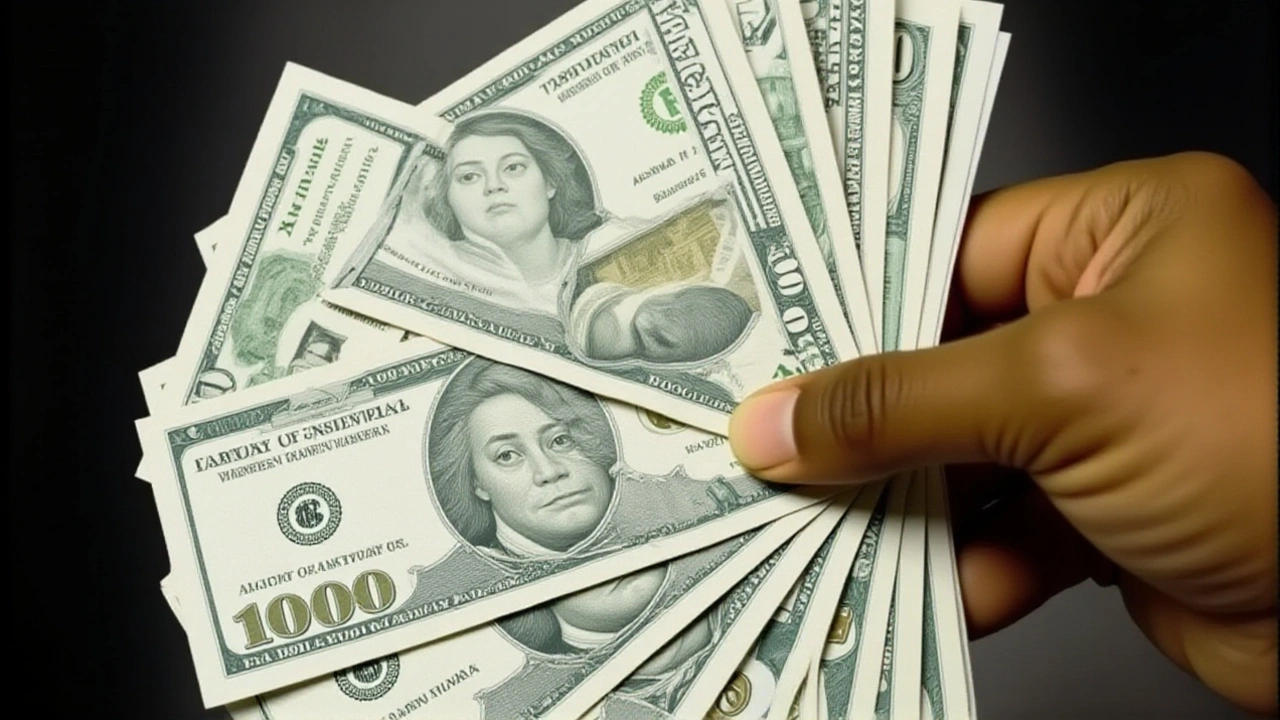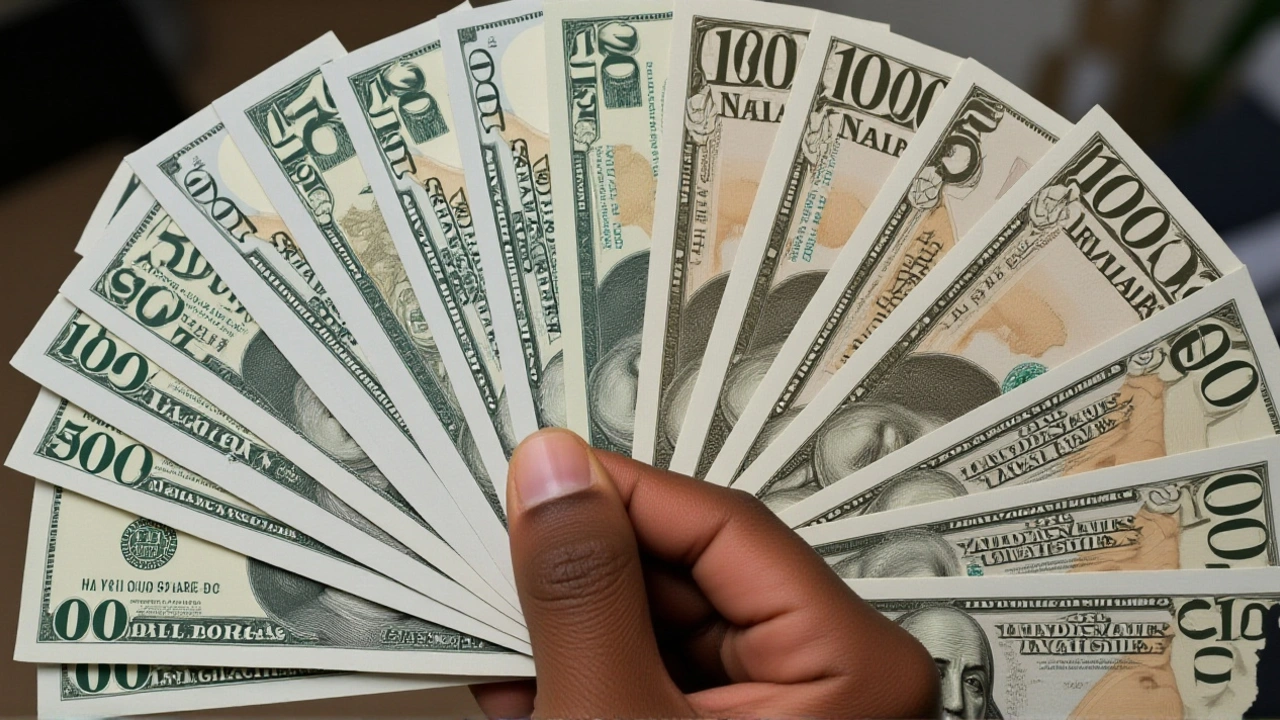
When the media whispered that the Nigerian naira had slid to N1,505 per U.S. dollar, most traders braced for a storm. The reality on the ground, however, painted a different picture. Data from the weekend of October 3‑4 2025 showed the parallel market hovering between N1,450 and N1,470, a modest gain rather than a plunge. Olayemi Cardoso, Governor of Central Bank of Nigeria addressed the confusion at the 302nd monetary policy committee meetingAbuja, where she unveiled fresh reserve figures and a sizable current‑account surplus. The numbers, she argued, were the real story behind the currency’s recent bounce.
What the Numbers Actually Show
Online rate aggregator NgnRates.com recorded a sell price of N1,470 on October 3, 2025, according to a user identifying as Yusuf Dan. The same platform listed N1,490 on both September 30 and October 2, and a slightly higher N1,510 on September 30. Buy rates were a shade lower – N1,450 on October 3 and N1,470 on the preceding two days. While the site cautions that user‑submitted figures aren’t guaranteed, they provide a transparent snapshot of market sentiment.
Contrasting those figures, The Nation newspaper reported a closing parallel rate of N1,450 per dollar on the same day, noting that this outperformed the official window rate of N1,475. The publication linked the gain to the CBN’s recent foreign‑exchange reforms, which aim to increase dollar availability and curb speculative swings.
Central Bank Reforms Under Cardoso
At the Abuja meeting, Governor Cardoso highlighted three key metrics that underpin the naira’s resilience:
- Gross external reserves rose to $43.05 billion as of September 11, 2025, up from $40.51 billion at the end of July.
- The import‑cover ratio improved to 8.28 months, a buffer that eases pressure on foreign‑exchange procurement.
- Second‑quarter 2025 current‑account surplus hit $5.28 billion, more than double the $2.85 billion recorded in Q1.
Cardoso explained that the CBN’s “creative” policy tools – such as the re‑introduction of the Euro‑bonds window and tighter monitoring of bureau‑de‑change operations – have encouraged genuine forex inflows while discouraging illicit arbitrage.
Market Voices: Operators and Analysts React
Aminu Gwadabe, President of the Association of Bureaux De Change Operators of Nigeria (ABCON), praised the CBN’s approach, saying, “We’re finally seeing a market where dollars move faster and at more transparent rates. That’s good news for businesses that need to import raw materials.” His remarks echoed a broader sentiment among forex traders who see the recent stability as a sign that the central bank’s policies are taking hold.
Analysts from local brokerages also weighed in, noting that the improved reserves give the CBN breathing room to intervene when speculative pressure spikes. One senior economist, who asked to remain unnamed, warned, “If the data keeps trending upward, we could see the parallel rate settle closer to the official window, which would be a win‑win for both importers and consumers.”
Why the Depreciation Rumor Matters
The claim that the naira had slipped to N1,505 sparked concern among import‑dependent sectors – from cement manufacturers to telecom firms – because a weaker naira inflates the cost of foreign‑sourced inputs. Even a short‑term dip can erode profit margins and push inflation higher.
However, the factual data suggests that the currency’s modest appreciation may actually ease those pressures. A stronger parallel rate translates to lower dollar‑price inputs, which can help keep consumer goods affordable. Moreover, the visible boost in reserves and current‑account surplus signals to investors that Nigeria is managing its external balances prudently, potentially attracting more foreign direct investment.
Looking Ahead: Risks and Opportunities
Despite the optimism, challenges remain. The AbokiFX platform, another popular source for parallel market rates, displayed zero values for Lagos‑based trades during the same period – a glitch that fuels uncertainty about data reliability. Market participants stress the need for consistent, real‑time reporting to avoid misinformation.
Going forward, the CBN has pledged to continue refining its forex allocation framework, aiming for greater transparency and broader access for legitimate traders. If the central bank can sustain the current trajectory of reserve accumulation and keep the import‑cover ratio above the six‑month threshold, the naira could inch closer to parity with the official window, easing the arbitrage gap that has long plagued the market.
Key Facts
- Parallel market rate (Oct 3 2025): N1,470–N1,490 per $.
- Official window rate (Oct 3 2025): N1,475 per $.
- External reserves: $43.05 billion (as of Sep 11 2025).
- Current‑account surplus Q2 2025: $5.28 billion.
- Import‑cover ratio: 8.28 months.

Frequently Asked Questions
How does the current naira rate affect import‑dependent businesses?
A stronger parallel rate, hovering around N1,450‑N1,470, reduces the dollar cost of raw materials. That eases pressure on profit margins for sectors like manufacturing and telecom, potentially slowing inflationary pass‑through to consumers.
What were the main drivers behind the CBN’s recent forex reforms?
Governor Cardoso highlighted reserve growth, higher import‑cover, and a sizable current‑account surplus. The reforms aim to channel legitimate foreign exchange into the market, curb speculative arbitrage, and improve transparency for bureaux de change.
Why did some reports claim the naira had slipped to N1,505?
Misinformation can stem from outdated data feeds, user‑submitted rates without verification, or simple typographical errors. Platforms like AbokiFX showed zero values during this period, highlighting the risk of relying on a single source.
What does a current‑account surplus of $5.28 billion mean for the economy?
A surplus indicates that Nigeria is earning more from exports and services than it spends on imports. This inflow strengthens foreign‑exchange reserves, supports the naira, and reduces the need for external borrowing.
Will the naira likely converge with the official window rate soon?
If the CBN maintains its reserve build‑up and keeps import‑cover above six months, market participants expect the parallel rate to narrow the gap with the official window, potentially stabilizing around N1,470 per dollar.
Comments (11)
-
John McDonald October 5, 2025
The recent data cascade underscores a systemic liquidity rebalancing that is catalyzing a virtuous cycle for the Naira.
Enhanced external reserve accruals elevate sovereign risk buffers, thereby depressing risk premia on foreign‑exchange inflows.
Concomitantly, the import‑cover ratio surpassing the eight‑month threshold signals operational resilience that mitigates speculative arbitrage.
From a macro‑fundamental perspective, the CBN’s calibrated re‑introduction of Euro‑bond windows serves as a conduit for portfolio inflows, reinforcing the foreign‑exchange supply side.
These policy levers collectively augment the monetary transmission mechanism, fostering price stability across the import‑dependent value chain.
When market participants internalize the improved fundamentals, the bid‑ask spread in the parallel market compresses, nudging rates toward the official window.
The observed parity drift reflects a reduction in the differential risk premium historically embedded in the arbitrage corridor.
Strategically, the CBN’s tighter oversight of BDC operations curtails illicit currency leakage, preserving net foreign‑exchange reserves.
Liquidity provision via controlled window allocations stabilizes the supply‑demand equilibrium, attenuating volatility spikes.
Coupled with the current‑account surplus, these dynamics engender a self‑reinforcing feedback loop that buttresses the Naira’s purchasing power.
The data also illustrates a decoupling of inflationary transmission from raw material import costs, offering a reprieve for domestic producers.
In a broader economic context, sustained reserve growth expands fiscal space, enabling countercyclical stimulus without exacerbating external debt burdens.
Thus, the convergence of macro‑prudential metrics underscores a trajectory toward exchange‑rate normalization.
Stakeholders should interpret these signals as a strategic inflection point rather than a fleeting anomaly.
Continued adherence to transparent allocation frameworks will be pivotal in cementing this nascent stability.
-
Jordyn Wade October 6, 2025
When one examines the aggregate of the recent foreign‑exchange reforms one sees a tapestry woven from reserve accumulation, import cover expansion, and surplus generation that together create a robust macroeconomic foundation which, in turn, encourages market participants to recalibrate their expectations and align more closely with official policy windows, thereby reducing speculative frictions and fostering a more predictable trading environment; this alignment is further reinforced by the central bank’s proactive communication strategy which, by shedding light on underlying data, diminishes the information asymmetry that often fuels volatility; consequently, businesses that rely heavily on imported inputs can anticipate a more stable cost structure, which not only preserves margin integrity but also supports broader economic growth through enhanced consumer confidence.
-
Zoe Birnbaum October 7, 2025
Great synthesis of the policy impact! The market’s response feels more coordinated now, and that optimism is contagious for traders on the floor.
-
Amber Brewer October 8, 2025
The parallel market data you referenced aligns with the central bank's published figures for the week, confirming that the sell‑side pressure has eased. Additionally, the current‑account surplus of $5.28 billion provides the CBN with ample intervention capacity. It’s worth noting that the import‑cover ratio of 8.28 months exceeds the critical six‑month threshold, which historically reduces the likelihood of abrupt devaluations. Traders should continue monitoring reserve inflows, as they remain the primary driver of rate stability. Overall, the fundamentals suggest a sustained period of modest appreciation.
-
Kim Coulter October 9, 2025
While the numbers look solid, it’s essential to recognize that true economic sovereignty comes from defending our currency against external manipulation. The reforms aren’t just technical tweaks; they embody a philosophy of self‑reliance that any nation must cherish. If we allow foreign speculation to dictate our rates, we betray the very spirit of independence that fuels national pride.
-
Michelle Toale-Burke October 10, 2025
Wow, the Naira is really showing its resilience! 😊 Seeing the rates hold steady gives me hope for the local economy.
-
Amy Paradise October 10, 2025
Totally agree, the steady rates are a breath of fresh air. 😎 It’s nice to see the market calm down after the hype.
-
Janette Cybulski October 11, 2025
That's a solid sign for importers.
-
Mildred Alonzo October 12, 2025
The discrepancy between the reported N1,505 figure and the actual market range highlights the importance of data verification. Platforms like AbokiFX can sometimes emit zero values, which adds confusion rather than clarity. Consistent, real‑time reporting would mitigate misinformation and help traders make informed decisions. Moreover, alignment between official and parallel rates reduces arbitrage opportunities, benefitting both businesses and consumers. Maintaining transparency should be a priority for all market participants.
-
Elizabeth Bennett October 13, 2025
Absolutely, transparency is the keystone of a functional forex market. Regulators must enforce rigorous reporting standards to eliminate spurious spikes. At the same time, market actors should cross‑reference multiple data sources before reacting. This collaborative diligence will preserve confidence and support the Naira’s upward trend.
-
linda menuhin October 13, 2025
yeah, i think when we all look at the same numbers, the market feels less like a mystery and more like a shared story. kinda cool how data can bring us together, huh?
